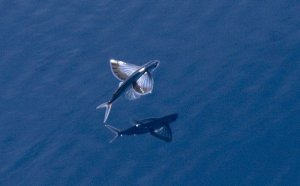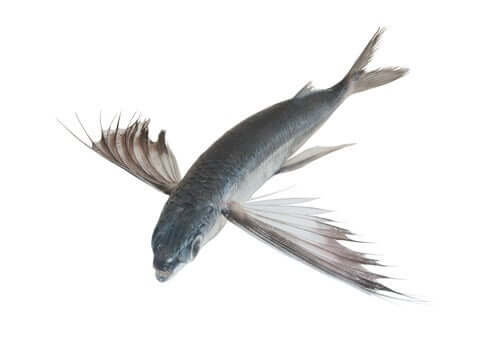3 Amazing Species of Flying Fish

Flying fish live in every single ocean and sea on the planet and there are lots of species of them. Seeing them burst out of the water as if they were birds is truly a sight to be seen. How are they able to do that? They have wings and a body perfectly adapted to take flight.
3 species of flying fish
Three of the most common species of flying fish are the tropical two-wing flying fish (exocoeutus volitans), the sharpchin flying fish (fodiator acutus), and the flying gurnard (dactyloperus volitans). Let’s take a more detailed look at these three harmless types of fish and their unique characteristics!
Tropical two-wing flying fish
This is one of the most common, most numerous species of flying fish on the planet. It’s not too hard to find one of these bursting out of the water. You just have to know where to look.

You’re most likely to find them around the coastal waters of Cuba, Nicaragua, Venezuela, Costa Rica, Florida, etc. In other words, basically any tropical areas with warm water. It’s rare to see them any deeper than 65 feet below the water.
Their long, hydrodynamic bodies make them extremely fast swimmers. But they also have an ace up their sleeve. They can jump out above the surface of the water to get away from predators like tuna, swordfish, and other large marine predators.
They can be up to 8 inches long, which makes them very vulnerable. This is why most of them live in large sandbanks along coastal areas and in the open seas, as they look for food.
One very special thing about them is that their huge wings give them the ability to be in the air for a long time, right above the surface of the water. They’re generally light blue on the bottom of their bodies, to blend in with the color of the sky. On the top part of their bodies they’re a bit darker, so that predators can’t see them from above.
Sharpchin flying fish
This odd species of flying fish has long, wide wings. These give it the ability to go extremely fast, both in and out of the water. Like the tropical two-wing flying fish, this species prefers to stay near the surface. It will rarely go more than 50 feet down.
They’re very common along the coast of Western Africa. You can also see them on the Western coasts of the Americas, all the way from the US down to Chile. They tend to stay very close to the coast, and in open seas as they travel long distances down sandbanks searching for food.
They never grow longer than 8 inches, but they tend to be closer to 6 inches. Their small size, along with their weight allow them to go long distances outside of the water, with the help of their strong pectoral wings. They’re also very useful for getting away from predators, which is why they stay close to the surface.

Like most species of flying fish, they mostly feed on plankton. They go extremely long distances in search of these little creatures, which sometimes means going too far from their comfort zone. This often leads to them being attacked by open sea predators like swordfish.
Flying gurnard
This species of flying fish is slightly bigger than the other two, closer to 10 inches at their longest. One unique thing about them is that they don’t have bones in their wings. This makes them flimsier, though they’re still tough.

Of the three, it’s the only species you’ll see in the Mediterranean. You can also find them in subtropical waters around the world, where the warmer water means lots of plankton and small crustaceans.
Like the tropical two-winged flying fish, it’s an expert at camouflage and every part of its body has a specific purpose. Its dark back helps it to go unnoticed on the seafloor, and a platinum blue bottom so that predators don’t see it while it’s in the air.
All three of these species are an amazing example of how nature can help a species survive. Seeing them in action as they fly over the water is an absolute marvel for every nature lover.
Flying fish live in every single ocean and sea on the planet and there are lots of species of them. Seeing them burst out of the water as if they were birds is truly a sight to be seen. How are they able to do that? They have wings and a body perfectly adapted to take flight.
3 species of flying fish
Three of the most common species of flying fish are the tropical two-wing flying fish (exocoeutus volitans), the sharpchin flying fish (fodiator acutus), and the flying gurnard (dactyloperus volitans). Let’s take a more detailed look at these three harmless types of fish and their unique characteristics!
Tropical two-wing flying fish
This is one of the most common, most numerous species of flying fish on the planet. It’s not too hard to find one of these bursting out of the water. You just have to know where to look.

You’re most likely to find them around the coastal waters of Cuba, Nicaragua, Venezuela, Costa Rica, Florida, etc. In other words, basically any tropical areas with warm water. It’s rare to see them any deeper than 65 feet below the water.
Their long, hydrodynamic bodies make them extremely fast swimmers. But they also have an ace up their sleeve. They can jump out above the surface of the water to get away from predators like tuna, swordfish, and other large marine predators.
They can be up to 8 inches long, which makes them very vulnerable. This is why most of them live in large sandbanks along coastal areas and in the open seas, as they look for food.
One very special thing about them is that their huge wings give them the ability to be in the air for a long time, right above the surface of the water. They’re generally light blue on the bottom of their bodies, to blend in with the color of the sky. On the top part of their bodies they’re a bit darker, so that predators can’t see them from above.
Sharpchin flying fish
This odd species of flying fish has long, wide wings. These give it the ability to go extremely fast, both in and out of the water. Like the tropical two-wing flying fish, this species prefers to stay near the surface. It will rarely go more than 50 feet down.
They’re very common along the coast of Western Africa. You can also see them on the Western coasts of the Americas, all the way from the US down to Chile. They tend to stay very close to the coast, and in open seas as they travel long distances down sandbanks searching for food.
They never grow longer than 8 inches, but they tend to be closer to 6 inches. Their small size, along with their weight allow them to go long distances outside of the water, with the help of their strong pectoral wings. They’re also very useful for getting away from predators, which is why they stay close to the surface.

Like most species of flying fish, they mostly feed on plankton. They go extremely long distances in search of these little creatures, which sometimes means going too far from their comfort zone. This often leads to them being attacked by open sea predators like swordfish.
Flying gurnard
This species of flying fish is slightly bigger than the other two, closer to 10 inches at their longest. One unique thing about them is that they don’t have bones in their wings. This makes them flimsier, though they’re still tough.

Of the three, it’s the only species you’ll see in the Mediterranean. You can also find them in subtropical waters around the world, where the warmer water means lots of plankton and small crustaceans.
Like the tropical two-winged flying fish, it’s an expert at camouflage and every part of its body has a specific purpose. Its dark back helps it to go unnoticed on the seafloor, and a platinum blue bottom so that predators don’t see it while it’s in the air.
All three of these species are an amazing example of how nature can help a species survive. Seeing them in action as they fly over the water is an absolute marvel for every nature lover.
All cited sources were thoroughly reviewed by our team to ensure their quality, reliability, currency, and validity. The bibliography of this article was considered reliable and of academic or scientific accuracy.
Hablemos de peces. Peces voladores: conoce sus características y mucho más.
-
hablemosdepeces.com/peces-voladores/
Fish Base. Pez volador de Sharpchin.
- fishbase.se/summary/Fodiator-acutus
National Geographic. El pez volador. Febrero de 2011.
- nationalgeographic.es/animales/pez-volador
This text is provided for informational purposes only and does not replace consultation with a professional. If in doubt, consult your specialist.








